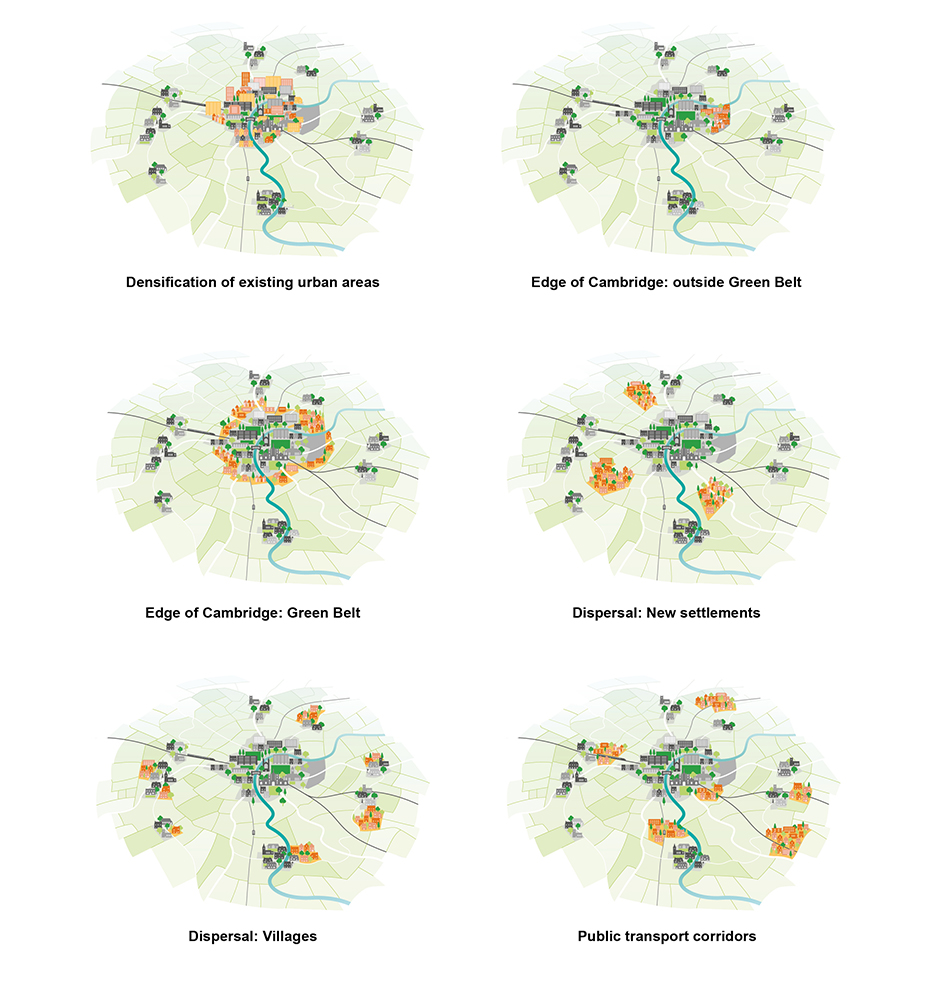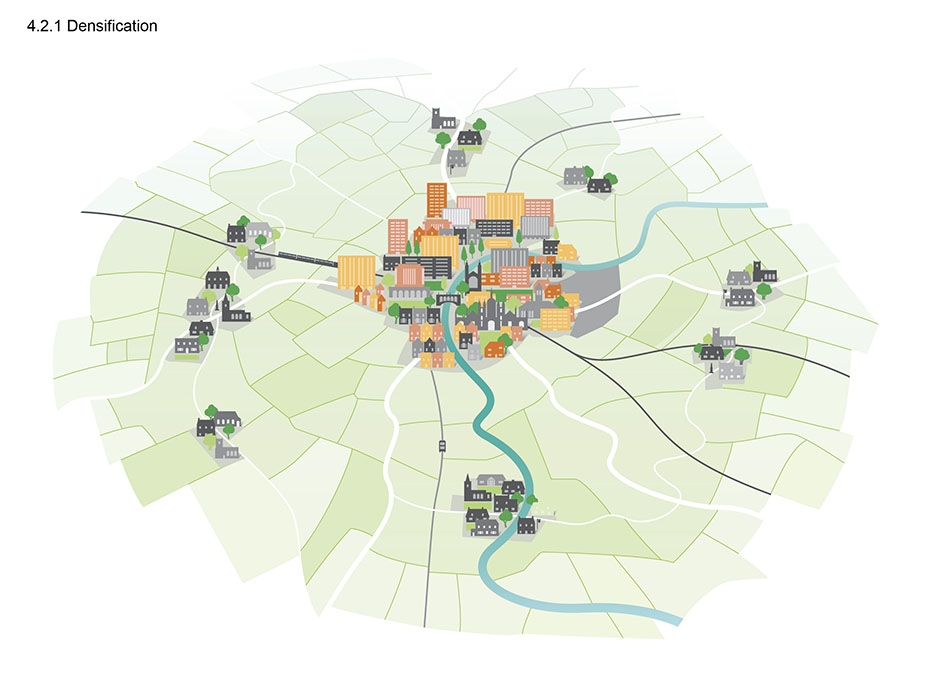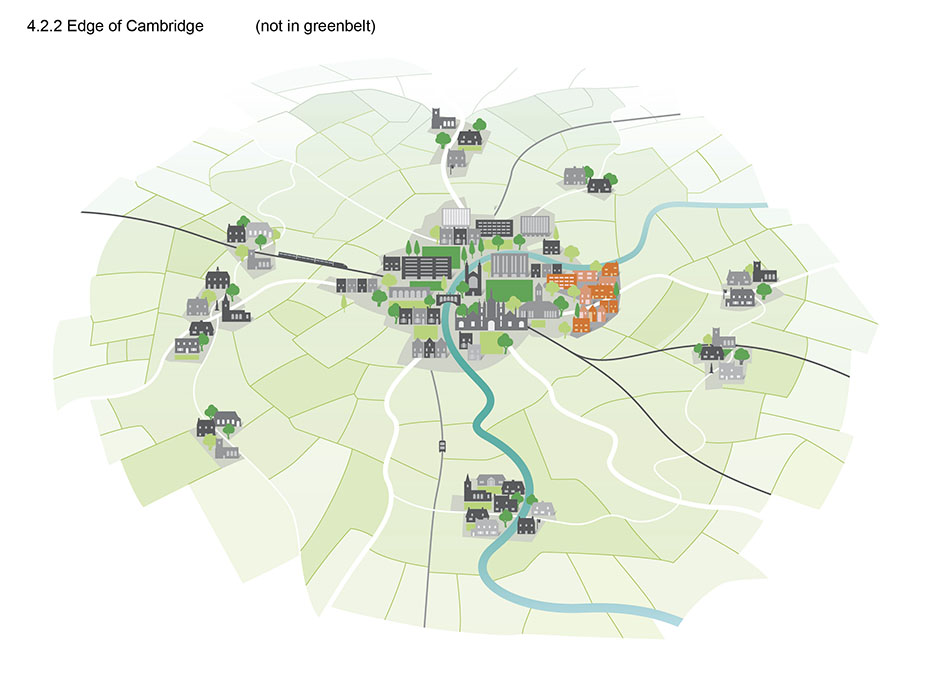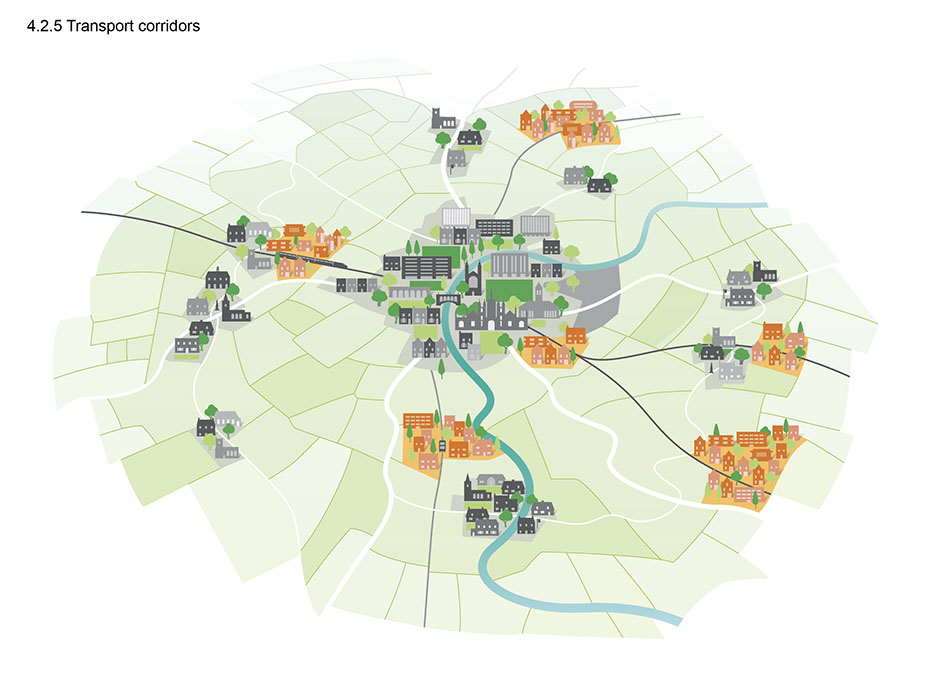5.3 What are the choices?
There are many different locations that we could choose to focus growth:
- Densification of existing urban areas
- Edge of Cambridge: Outside Green Belt
- Edge of Cambridge: Green Belt
- Dispersal: New Settlements
- Dispersal: Villages
- Public transport corridors
Figure 26: Illustrative comparison between potential growth strategies
There is more detail in this section about these different locations, and their advantages and disadvantages. They cover a broad range of location choices, and the chosen strategy for the Local Plan could involve growth in all or most of them, to some extent.
Choices in the proportions of growth in different locations will be influenced by the prioritisation of the big themes in this consultation, such as:
- Climate change – our net zero carbon target suggests that we should site development in places which can reduce the need to travel by private car.
- Biodiversity and green spaces – this could be through large scale new development that could come with accompanying large-scale green space, or contributions from smaller sites that can be pooled towards providing green space elsewhere.
- Wellbeing and social inclusion – locating new development where it can bring wider benefits to existing communities in terms of access to services, facilities and green space. Development could also enable access to a range of job opportunities for both existing and new communities.
- Great places – siting development where it provides opportunities to protect, enhance and improve places and deliver high quality design.
- Jobs – The success of the high technology jobs cluster in and around Cambridge is based in part upon businesses in key sectors being allowed to locate where there is good access to each other and to Cambridge so that businesses can work together. Equally, allowing some jobs growth in villages can help sustain local services and sustain vibrant communities.
- Homes – the distance and journey time between homes and jobs, and encouraging residents to use sustainable transport to get to work. We will need to consider whether different locations affect viability for delivering affordable homes.
- Infrastructure – access to existing and planned public transport, walking and cycling, would enable people to get to live their lives in a way that reduces greenhouse gas emissions.
The Councils are required to consider the implications of the choices open to us and how they impact sustainability for the area. The Sustainability Appraisal [DJ2]considers each of these options in further detail.
Question
(233) 42. Where should we site new development? Rank the options below 1‑6 (1 – Most Preferred 6 – Least Preferred)
5.3.1 Densification of existing urban areas
This approach would focus new homes and jobs within Cambridge, because it is the main urban area and centre for services and facilities. This would be done by encouraging intensive use of brownfield land, building taller buildings, building on existing residential back gardens or in-between existing buildings, or redeveloping underused sites at higher densities. It could also look to increase the density in planned new settlements.
Advantages:
- Reduces the need to use greenfield land to accommodate growth.
- Living in central, well-connected and vibrant areas is important for many people.
- Reduces the need to travel by car and so makes a positive contribution to addressing climate change.
- Sites growth near to existing centres, which can continue to support their vitality and viability.
Challenges:
- Needs to respond to the character of Cambridge, and protect its historic environment and green spaces, and therefore not suitable in all areas.
- Land assembly can be challenging with multiple landowners often involved.
Question
(110) 43. What do you think about densification?
Figure 27: Densification of existing urban areas (concept illustration)
5.3.2 Edge of Cambridge – outside the Green Belt
This approach would create new homes and jobs in extensions on the edge of Cambridge, using land not in the green belt. The only large site on the edge of Cambridge not in the Green Belt is Cambridge Airport.
Advantages:
- Benefits from the services and infrastructure at the existing centre, maximising the potential for sustainable transport.
- Large scale urban extensions present the opportunity for new on-site infrastructure, such as schools, local centres and green spaces that can bring benefits to the existing and new community.
- Cambridge Airport has previously been identified as suitable location for a new urban quarter to Cambridge and was removed from the Green Belt in earlier plans. It is identified as safeguarded land for longer term development in the 2018 Local Plans if it becomes available.
- Makes use of brownfield land.
Challenges:
- Confirmation whether safeguarded land at Cambridge Airport can be developed within the next 20 years will be important as part of considering whether to allocate it in the new Local Plan.
Question
(89) 44. What do you think about developing around the edge of Cambridge on land outside the Green Belt?
Figure 28: Edge of Cambridge: outside Green Belt (concept illustration)
5.4.3 Edge of Cambridge – Green Belt
This approach would create new homes and jobs in extensions on the edge of Cambridge, involving release of land from the Green Belt.
Advantages:
- Benefits from the services and infrastructure at the existing centre, maximising the potential for sustainable transport.
- Large scale urban extensions present the opportunity for new on-site infrastructure, such as schools, local centres and green spaces that can bring benefits to the existing and new community.
Challenges:
- Requires the use of greenfield land on the edge of urban areas, which around Cambridge would require the release of Green Belt land. National planning policy is clear that Green Belt boundaries should only be altered where exceptional circumstances are fully evidenced and justified, through the preparation or updating of plans. This includes a requirement that all other reasonable options, including working with neighbouring districts, have been fully explored. It also says that when reviewing Green Belt boundaries, the need to promote sustainable patterns of development should be taken into account.
Question
(115) 45. What do you think about developing around the edge of Cambridge in the Green Belt?
Figure 29: Edge of Cambridge: within Green Belt (concept illustration)
5.3.4 Dispersal: new settlements
New settlements would establish a whole new town or village, providing homes, jobs and supporting infrastructure in a new location, and would need to be supported by strategic transport infrastructure connecting to Cambridge.
Advantages:
- Provides an opportunity for significant new infrastructure to be delivered.
- Provides an opportunity for substantial growth in a new location connected to the transport network.
- May avoid removing land from the Green Belt
Challenges:
- Potential major impact on the landscape and loss of agricultural land.
- Can take longer to become reality, due to starting from scratch.
- Where it relies on proposed new transport infrastructure, even where it is included in the plans of the transport authorities, the level of certainty over delivery and timing of that infrastructure is crucial.
Question
(102) 46. What do you think about creating planned new settlements?
Figure 30: Dispersal: new settlements (concept illustration)
5.3.5 Dispersal: Villages
This approach would spread new homes and jobs out to the villages.
Advantages:
- Can help to sustain existing facilities and infrastructure in the village.
- Can help provide for a diversity of population in the village.
Challenges:
- Can result in increased commuting by car, and travel to access to services and facilities, particularly if the village is away from main transport corridors.
- Small sites are unlikely to significantly contribute to improvements to infrastructure so services capacity within or accessible to a particular village is important.
- Potential impact on village character needs to be considered.
- Some of the larger better served villages are surrounded by the Green Belt.
Question
(182) 47. What do you think about growing our villages?
Figure 31:Dispersal: villages (concept illustration)
5.3.6 Public Transport Corridors
This approach would focus homes and jobs along key public transport corridors and around transport hubs, extending out from Cambridge. This could be by expanding or intensifying existing settlements, or with more new settlements.
Advantages:
- Concentrates development on transport corridors where there are opportunities for high quality public transport.
- Supports expansion of economic benefits outwards from Cambridge.
Challenges:
- Requires the use of land along transport corridors, which may include locations within the Green Belt. This approach has implications for fundamentally changing the nature of the Cambridge Green Belt.
- Weight to be given to proposed new strategic transport infrastructure, even where it is included in the plans of the transport authorities, will depend on the level of certainty over delivery and timing of that infrastructure.
Question
(138) 48. What do you think about siting development along transport corridors?
Figure 32: Public transport corridors (concept illustration)







